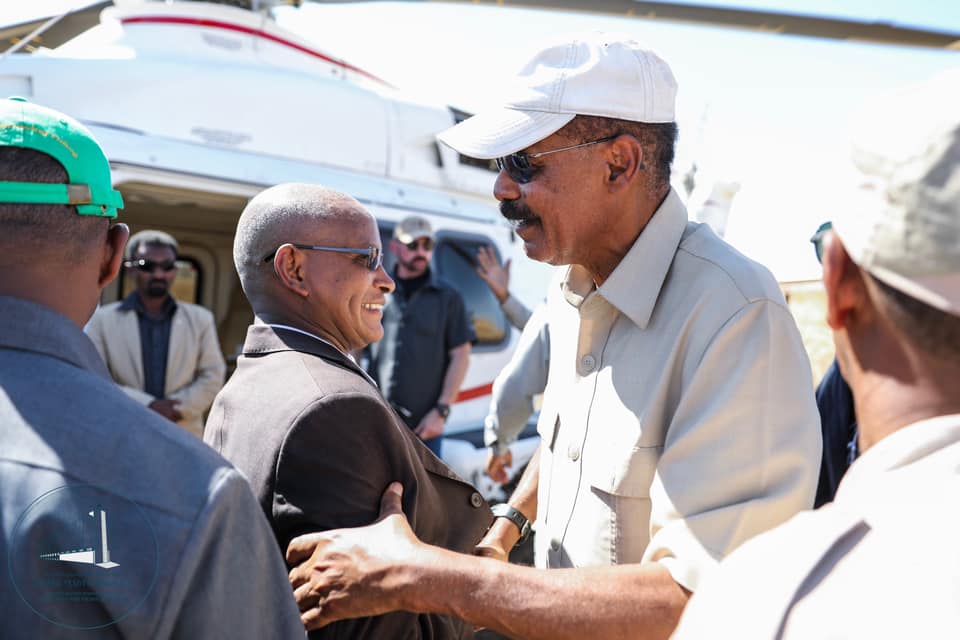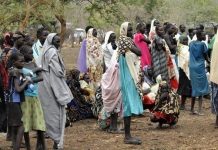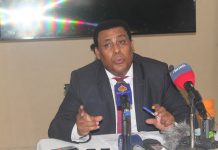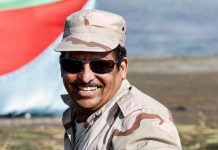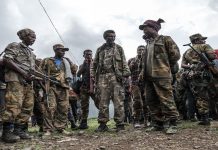AfricaPress-Eritrea: Eritrea, the tiny Horn of Africa nation is once again in the international spotlight for its atrocious military campaign in Tigray, Ethiopia’s northernmost regional state. Eritrean forces (EDF) are fighting alongside the Ethiopian federal army (ENDF) in the war against the rebellious regional leadership and the Tigray Defence Forces (TDF).
What is Eritrea’s objective in the war? And, how will it impact the one-man rule of President Isaias Afwerki?
To understand current Eritrean policies, one needs to discern the mindset of its autocratic president, the former guerrilla leader of Eritrean People’s Liberation Front (EPLF), who has ruled the totalitarian one-party state with an iron fist since independence.
Africa’s Sparta
Isaias has incessantly demarcated the borders of Africa’s second newest country through bloodshed and sacrifices—as Eritrea has been at war with all its neighbours since its independence in 1993.
In 1995, it clashed with Yemen over the Hanish Islands in the Red Sea and in 1996 with Sudan, before the devastating border war with Ethiopia from 1998-2000. In 2008, Eritrea picked a fight with its tiny southern neighbour Djibouti, also over a strip of contested territory. In all these conflicts, Eritrea was the first to launch military engagement—and tens of thousands of youths have perished on the battlefields to sustain the image of the country as an invincible warrior nation.
Isaias, meanwhile, attributes blame for the endless conflicts brought upon Eritrea to external forces, usually the USA, which he claims harbours an interest to “keep Eritrea hostage through the continuous fomenting and ‘managing’ of crises.”
Eritrea has been called the modern Sparta State, as its martial traditions with never-ending military service and constant war campaigns resemble that of the ancient Greek city-state. Isaias asserts that the Eritrean nation was born through sacrifice and blood, and the new post-independence generations need to suffer and experience shared hardships as endured by their parents, to constantly recreate and manifest an Eritrean nationalist military ethos.
Compulsory military national service for all women and men between the ages of 18 and 55 was imposed soon after independence. It was supposed to be limited to an 18-month period of service, but since the outbreak of the Ethiopian war in 1998, many have been forced to remain on duty. Youth recruited to fight Ethiopia in the late 1990s are now middle-aged. Today, once again, they are engaged in the war in Tigray.
Settling scores
In 1998 Eritrea launched an offensive against Ethiopia, ostensibly over a sliver of territory along the border to Tigray. The war’s root causes, however, were found in differences of ideology, economic policy, and development visions between the two new governments in Asmara and Addis Ababa.
The Tigray People’s Liberation Front (TPLF) constituted the senior Ethiopian political and military leadership at that time, as they were the dominant party within the EPRDF government coalition. When attacked, the late Ethiopian Prime Minister and former TPLF guerrilla leader Meles Zenawi ordered full war mobilization in Ethiopia, and the regional leadership in Tigray called back the old guerrilla army to service.
During a two-year period of fighting, over 100,000 combatants were killed, before the Ethiopian army finally managed to crush the Eritrean forces and push them out of Tigray.
The humiliating military defeat of his ‘invincible’ army has been a heavy burden for Isaias to carry ever since. The current full-scale military invasion of Tigray is thus likely driven by the desire for vengeance and to settle old scores, as Isaias apparently has ordered his forces to undertake what may appear to be a genocidal campaign against Tigrayans.
Beyond vengeance against the TPLF, some argue that Isaias also harbours an interest in unmaking the ethnic configuration of the Ethiopian federation, with the aim of realigning Eritrea with Ethiopia—a vision staunchly opposed by TPLF but seems to be backed by Prime Minister Abiy Ahmed. Issues on the table include a federal/ confederal arrangement, the merger of the two national armies, an Ethiopian navy base in the Eritrean Red Sea ports, and joint mineral exploration in border areas.
In spite of possible benefits, Eritrean nationalists in exile are afraid Isaias will squander the hard-won independence, for the sake of his own personal ambitions to become the ‘big man’ of the Horn of Africa in an Eritrean-Ethiopian federation.
Isaias’ final war?
Abiy promised that the war campaign against Tigray would be a ‘quick-fix’ law enforcement operation; half a year later, he admits that they are still fighting a “difficult and tiresome” guerrilla war in the region. Without Eritrea’s entrenched involvement in the war, the ENDF would struggle even more.
Isaias has committed most of the country’s military resources to the Tigray war campaign. Tens of thousands of Eritrean troops are currently fighting and dying in Tigray. Debretsion Gebremichael, the ousted regional President of Tigray and the head of TDF, claims that the heavy losses inflicted upon EDF in the past few months is depleting their fighting capacity.
On a satellite link from the field, Debretsion told me: “During the last two months, we have been fighting eight Eritrean divisions at the same time. Still, they did not manage to penetrate our defence.”
He further claimed, “Now, one Eritrean division does not dare to move alone–they have to deploy together in three or four divisions.” As a result, Debretsion asserted, EDF’s capability “is declining” and “their movement is also constrained.”
Ethiopia is blatantly rejecting TDF’s claims of holding the upper hand in the fight. The government spokesperson stated on 3 June that ENDF is currently “finalizing operations” to achieve the law enforcement objective to arrest or eliminate the TPLF ‘junta’. However, the TDF counter-offensive ‘Operation Alula,’ launched on 18 June, has reportedly ‘liberated’ swaths of territories and towns across central and eastern Tigray, and thousands of ENDF soldiers are taken as prisoners of war.
From inside Eritrea, an edgy voice of an Arbi Harnet (Freedom Friday) opposition activist, who must remain anonymous for their safety, conveyed growing sentiments of despair: “The war has a bad impact on the government. Although the people have been losing faith in the government for a while, this will be the final blow for those who were perhaps not as convinced.”
The source also described an environment of “mistrust and betrayals” prevalent within the Eritrean army. He said, “when President Isaias Afwerki tries to escape from taking responsibility for this, it is obvious that it will devastate his chances of staying in power.”
Isaias cannot afford to lose yet another war in Tigray. Nor can he afford to diminish Eritrea’s military capacity too much, as this will make Eritrea vulnerable for a subsequent TDF offensive or open up for domestic unrest. If he fails in Tigray, it may likely lead to his downfall.
As the war rages, TDF is actively encouraging Eritrean troops and officers to defect and join the Eritrean opposition forces in Tigray, or to flee to a third country. Activists and opposition parties in the diaspora are scenting blood and have again started to argue for the establishment of an Eritrean Government in exile, although this has failed on two previous occasions due to the deep mistrust and divisions among Eritrean communities, a legacy of Isaias’ divide-and-rule strategy and surveillance state.
The former Ethiopian Chief of Staff and senior TPLF military leader, Lieutenant General Tsadkan Gebretensae—who retired after the Eritrean-Ethiopian war in 2001—is back again in the field, commanding TDF forces in the fight against Eritrea.
In a recent interview, he states that the Eritrean forces have two options: “The first one is for them to quickly leave Tigray, go back to their country and prolong their time–if they have any left.” He said that what follows from there would be up to the people of Eritrea.
The second option, said Tsadkan, is “to stay in Tigray and try to finish the war here.” According to him, taking option number two “will quicken [EDF]’s death.”
Recent military developments indicate that Isaias is not betting on one horse alone but is instead crafting contingency plans. The TDF leader Debretsion stated to me that Eritrean forces are building fortifications in northern Tigray, possibly as fallback positions after their withdrawal from southern and central Tigray. Furthermore, Eritrea is building new trenches all along their side of the border, to prepare to fight back against a future potential Tigray offensive.
Pariah, again
The UN Security Council imposed sanctions on Eritrea in 2009 due to its destabilizing role in the Horn of Africa, and for its alleged role in fanning conflicts in Somalia and Djibouti. The TPLF/EPRDF-led Ethiopian government at the time, together with Djibouti, rallied support from all African states in favour of sanctioning Eritrea.
As part of the Ethiopia-Eritrea peace declaration in 2018, however, and after Abiy’s request, the UN lifted the sanctions against Eritrea.
Today, due to the war crimes and atrocities perpetrated in Tigray, the US has imposed unilateral sanctions on the belligerent parties. Discussions on reimposing UN sanctions on Eritrea are also being raised.
Over 90 percent of Tigray’s population is now in need of humanitarian aid, due in large part to the deliberate destruction and looting of food and farm equipment. Still, the Ethiopian government has restricted humanitarian access, and Eritrean and Ethiopian troops on the ground have been accused of blocking the distribution of aid in famine struck areas.
Fears of a famine of biblical proportions, with hundreds of thousands dying, has led the US, UK, and UN to call for a humanitarian cease-fire, in order to meet the growing needs of a starving population. This call has been rejected by the Ethiopian government.
What next, Eritrea?
Thirty years after independence, the Eritrean people are more divided than at any time before. Hundreds of thousands of youths have fled the country in the last two decades, due to factors that include indefinite military service and human rights abuses.
Still, Isaias has ordered his army to continue fighting in neighbouring Tigray and even in Oromia regional state where there are reports of Eritrean troops fighting the Oromo Liberation Army (OLA) insurgency. Eritrea’s minuscule population of around 3 million cannot replenish the military attrition rate much longer.
Inside Eritrea, opposition parties are prohibited, civil society is non-existent, and the ancient regime has been thoroughly corrupted. If the ‘strong man’ falls, what will happen to a state without any functioning political institutions beyond the military? No matter the outcome of the Tigray war, the survival of the Eritrea state may be in question.


